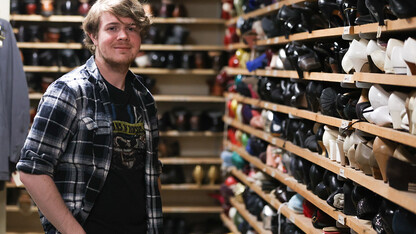· 6 min read
Nebraska in the national news: January 2023

A University of Nebraska–Lincoln faculty member’s innovative space-related research and a Husker-led team’s discovery of the first virus-eating microorganism garnered national media attention in January. The stories were among 25-plus featuring Husker faculty, staff, centers and programs during the month.
Congrui (Grace) Jin, assistant professor of civil and environmental engineering, recently earned a $175,000 NASA Innovative Advanced Concepts grant to flesh out her idea for growing bricks on Mars. She proposes creating bricks from fungi and cyanobacteria rather than shipping prefabricated materials from Earth. “These self-growing building blocks can later be assembled into various structures, such as floors, walls, partitions and furniture,” she told Engadget. Stories on the research also appeared in KETV, Gizmodo, Universe Today and Wired.
John DeLong, associate professor of biological sciences, and colleagues have found that a species of Halteria — microscopic ciliates that populate freshwater worldwide — can eat huge numbers of infectious chloroviruses that share their aquatic habitat. For the first time, the team’s lab experiments have also shown that a virus-only diet, which the team calls “virovory,” is enough to fuel the physiological growth and even population growth of an organism. The research continued to receive media coverage in January, appearing in Live Science, National Geographic, Science and Science News.
Additional national news coverage in January includes:
Deirdre Cooper Owens, history, director of the Humanities in Medicine program, was interviewed for a Jan. 4 NPR story on why women’s health concerns are dismissed so often. She is the author of “Medical Bondage: Race, Gender and the Origins of American Gynecology.”
New Scientist published a Jan. 4 review of “Parasites: The Inside Story” by Husker researchers Scott Gardner, NU State Museum; Judy Diamond, University Libraries; and Gabor Rácz, NU State Museum. (This article requires a subscription.)
Danielle Jefferis, law, was quoted in a Jan. 6 STAT article on officials in Nebraska, Oklahoma and South Dakota beginning to investigate prisons’ hepatitis C treatment efforts. “It’s pretty clear that a lot of the people in Nebraska who need this lifesaving medical care for [hepatitis] C have a viable claim under the Eighth Amendment,” said Jefferis, who specializes in prisoner rights.
David Berkowitz, chemistry, was the featured guest on the Molecular Moments podcast on Jan. 6. He discussed his educational background, his involvement with the National Strategic Research Institute, his work with enzymes, how higher education has changed over the years and his participation in the Lincoln Marathon.
Tala Awada, School of Natural Resources, associate dean of the Agricultural Research Division, was interviewed for a Jan. 10 Nebraska Public Media story on the aftermath of the Bovee Fire, which destroyed about a quarter of the hand-planted Nebraska National Forest near Halsey last fall. Awada and Husker colleagues have submitted a grant proposal to record not only which system re-emerges in the burn zone — grassland or woodland — but which factors most influence its recovery. KCUR picked up the story.
By resurrecting the hemoglobin of ancient crocodilian ancestors, Jay Storz, biological sciences, and colleagues have helped explain why other vertebrates failed to evolve the adaptations that allow crocs to go hours without air. Newsweek published a Jan. 13 article on the research. The story was picked up by MSN.com and several other media outlets.
A photo illustration by Scott Schrage, University Communication and Marketing, was featured in a Jan. 13 Defector article titled “More scientific images should go this hard.” The image accompanied a Nebraska Today article on the Jay Storz-led study mentioned above.
Thanks to a new study led by the University of Nebraska–Lincoln, seashore paspalum — the official turfgrass of the 2022 World Cup — may soon assist another goal: growing crops that yield more food with less fertilizer. Anthropocene magazine published a Jan. 13 article on the research.
Guangchao Sun, a Husker doctoral alumnus and former postdoctoral researcher at Nebraska, was interviewed about the paspalum study above for the Jan. 28 episode of the No Time to Read podcast.
Patricio Grassini, agronomy and horticulture, was the featured guest on the Jan. 16 episode of the Earth911 podcast. He discussed climate impacts on grain and cooking oil crop yields.
Rebecca Roston, biochemistry, was interviewed for a Scientific American article on a new study showing the biofuel potential of duckweed. Roston, who was not involved in the study, said engineered green plants typically expend a lot of energy on oil production and thus stop growing. For the new study, the researchers added an oil-producing gene that would be inactive at first, then switched on by introducing a particular molecule only when the plant had finished growing.
Frans von der Dunk, law, was interviewed for a Jan. 21 Mashable article on who owns the moon’s ice. He said the leading interpretation resembles international law governing the high seas, with no single nation able to claim all the resources but licensed companies able to extract and sell them. “We need to build more concrete details,” he said.
Kate Lyons, biological sciences, was interviewed for a Jan. 23 BBC Future article titled “Why giant prehistoric animals got smaller.” She noted that large animals with plant-based diets release a lot of energy as heat during digestion. “Elephants are essentially giant walking fermentation vats, a giant dinosaur is basically a walking brewery, so they generate a lot of heat,” she said.
A research team led by Sunil Sukumaran, nutrition and health sciences, has found that a subset of taste cells called type II taste cells may play a key role in the body’s immune response to harmful oral microbes. Neuroscience News ran a Jan. 23 article on the research.
The university’s Teachers and Parents as Partners program was featured in a Jan. 26 News Nation article. The program aims to increase communication between parents and educators. Susan Sheridan, director of the Nebraska Center for Research on Children, Youth, Families and Schools and TAPP’s lead consultant, was interviewed for the story.
Brian Bornstein, professor emeritus of psychology, was interviewed for a Jan. 30 Baltimore Banner article on more than a third of Baltimore residents failing to show up when summoned for jury duty. “There’s a (national) movement to make things more juror-friendly,” said Bornstein, co-author of the book “The Jury Under Fire: Myth, Controversy and Reform.” “It is maybe part of a larger societal trend to empower consumers more.”
E.W. Scripps aired a Jan. 31 story on the university’s Rural Law Opportunities Program, which aims to increase the number of attorneys in rural communities. Richard Moberly, dean of the College of Law, and John Paul Svec, a recent alumnus of the college, were interviewed for the story, which was picked up by 30-plus media outlets across the country.
Kyle Langvardt, assistant professor of law, was interviewed for a Jan. 31 DL News article on coders facing criminal charges for developing apps used for laundering crypto payments. “One thing you can’t generally do in law is avoid liability by taking steps to avoid having knowledge of facts that would otherwise implicate you in unlawful conduct,” he said. “This is called the willful blindness’ doctrine.”
Faculty, administration, student and staff appearances in the national media are logged at http://newsroom.unl.edu/inthenews. If you have additions to the list, contact Sean Hagewood at shagewood2@unl.edu or 402-472-8514. If you have suggestions for national news stories, contact Leslie Reed at lreed5@unl.edu or 402-472-2059.







